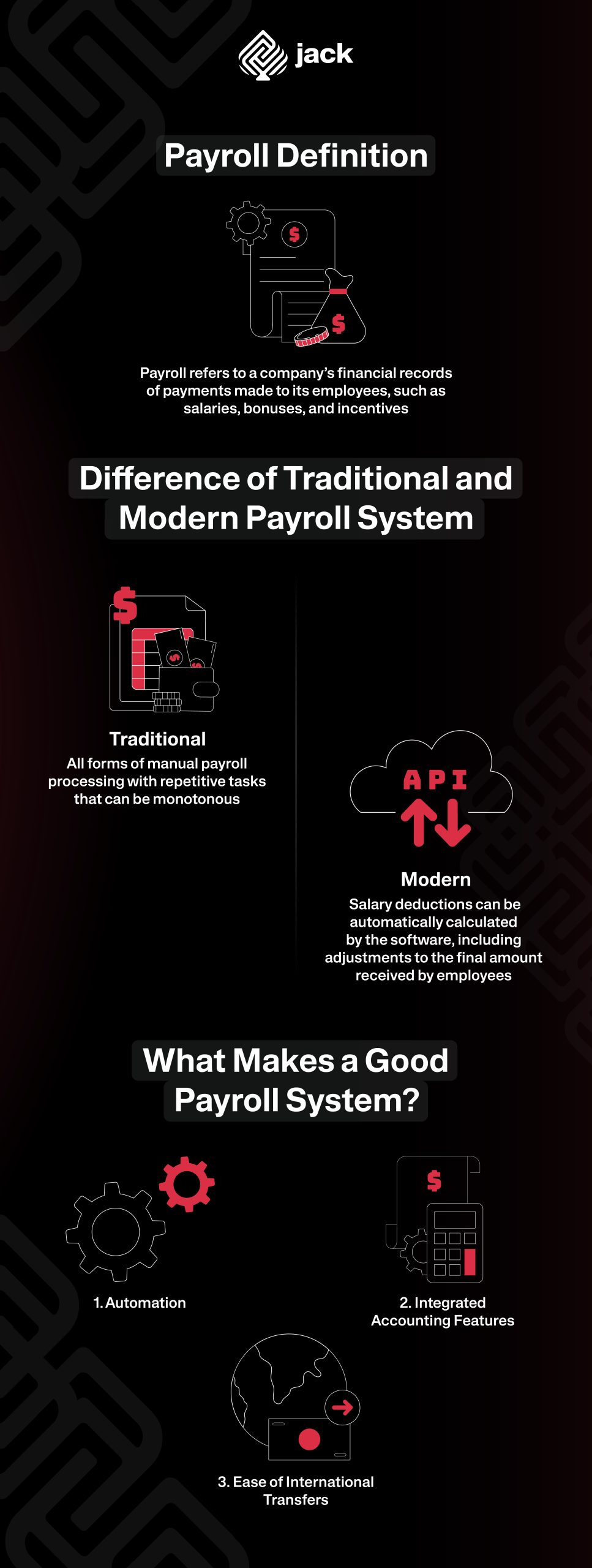Want to manage payroll efficiently but don’t know where to start? Managing payroll is an important part of every business, but many still use outdated methods. Payroll management has become more complex, especially when employee wages are based on hours worked or project-based payments, as is the case with freelancers.
There are also bonuses typically received by frontliners and field workers. This article will discuss what payroll is and how to manage payroll with the right systems and tools.
Payroll Definition
According to Indeed, payroll refers to a company’s financial records of payments made to its employees, such as salaries, bonuses, and incentives. Payroll is commonly known as the activity of paying employees. Many businesses use software to manage their payroll systems.
There are various names attached to payroll management software products, ranging from payroll software to HRIS or HR management software. However, their functions are relatively similar as platforms that include payroll management as one of their features.
Before delving deeper into tools for managing payroll, let’s understand the components, stages, and types of payroll systems in general.

Components of Payroll Systems
Although there are many components in the payroll process, there are at least three main components:
1. Employee Information
New employees are usually required to complete several administrative tasks, one of which is providing their personal data. The basic information that needs to be completed includes full name, residential address, taxpayer identification number (NPWP), and social security number. This data can facilitate the finance department in processing payroll and handling tax deductions.
2. Salary Payment
The salary amount is the main component of the payroll system. The salary record will detail everything related to the payment of wages to employees, including gross salary, deductions, net salary, total working hours, overtime pay, reimbursement, bonuses, and more.
3. Deductions
The salary will be transferred to employees after all deductions are calculated. These deductions include the amount to be paid for income tax, social security contributions, and various benefit deductions such as health insurance.
Stages of the Payroll System
According to Multiplier, payroll processing involves a series of stages consisting of five main steps:
1. Data Collection
Every payroll period, relevant data needs to be collected, such as working hours, attendance, leaves, overtime, and so on. All this information can be obtained from employee attendance records or routine reports from managers.
2. Net Salary Calculation
Net salary is the result after deducting taxes from the gross salary. These deductions usually include social security contributions, insurance, allowances, and unpaid leave deductions.
3. Payment Distribution
After deductions are made and the net salary amount is recorded in the system, the payroll administrator will send the salary to each employee’s account. The salary payment mechanism can vary from company to company, ranging from direct deposits to bank accounts or through checks.
4. Tax Filing
After the distribution of salary payments is completed, the company still needs to file income tax with the relevant authorities. Tax filing is one of the company’s obligations carried out on behalf of each employee.
5. Tax Payment
In this stage, the company remits taxes and other obligations such as social security contributions. In Indonesia, income tax payment is part of the company’s obligations, while reporting still needs to be done by employees annually.
Example of Employee Payroll Calculation
Salary calculations for employees in Indonesia follow Law Number 6 of 2023 concerning Job Creation (Cipta Kerja Law), which eliminates the District/City Minimum Wage (UMK) and Sectoral Minimum Wage (UMSK), leaving only the Provincial Minimum Wage (UMP) applicable.
The UMP amount is now the benchmark for companies in determining employee salaries. Based on the applicable regulations, the salary components can consist of:
- Basic salary without allowances
- Basic salary and fixed allowances
- Basic salary, fixed allowances, and variable allowances; or
- Basic salary and variable allowances
For example, a marketing staff in Jakarta receives a salary with the components of basic salary and fixed allowances. The minimum amount of basic salary that the employee should receive is 75% of the total basic salary and fixed allowances, calculated using the following formula:
Received Salary = Basic Salary (minimum 75%) + Fixed Allowances (maximum 25%)
Let’s say the company sets the salary for the marketing staff with the following details:
Basic Salary: Rp5,025,000
Fixed Allowances: Rp1,675,000
The calculation above is in accordance with the regulations because the percentage of the basic salary is 75% of the total salary received by the employee, with 25% of it being fixed allowances. If totaled, the received salary amounts to Rp6,700,000, which is also not less than the local UMP in 2023, which is Rp4,901,798.
What if there are deductions for income tax, social security contributions, and others? The calculations should always refer back to the UMP in each respective region as the minimum standard for the net salary that employees should receive.
Types of Payroll Systems
Each company has different payroll systems. There are several options that can be used, as quoted from Intuit QuickBooks:
1. In-house Payroll
This system is implemented when the company manages its payroll system manually in each payroll period. With this method, the business owner is usually directly involved in managing employee salaries, either independently or with the help of HR personnel.
Although it can be an economical choice for small-scale businesses, this system becomes challenging to sustain as the workforce grows.
2. Outsourcing
Companies can hire the services of an accounting firm to manage payroll and income tax payments. All payroll-related matters, including taxes, will be handled by the accountant from start to finish, including providing consultation throughout the process.
3. Payroll Service
There are businesses that specialized in providing payroll management services to other companies. These businesses operate as B2B service providers, handling the full management of payroll for their clients. They often also offer tax filing services on behalf of the company.
4. Payroll Software
With the help of dedicated payroll software, companies can automate payroll processing entirely. The use of software provides a solution to minimize human errors and speed up repetitive tasks that can be monotonous and replaced by machines. For example, salary deductions can be automatically calculated by the software, including adjustments to the final amount received by employees.
Why Use Software to Manage Payroll?
Among the types of payroll systems mentioned earlier, the option of using software has several advantages in terms of process automation. In addition, there are many other benefits compared to using traditional payroll systems. Some of them include:
- Speeding up the onboarding process for new employees because payroll software can consolidate various data, such as salary lists, bank account details, tax status, and deduction information.
- Generating in-depth reports on employee performance and benefits, such as attendance reports and reimbursements for expenses incurred by employees.
- Tracking average employee salaries to have a better understanding of the compensation provided compared to industry wage standards.
- Streamlined accounting and financial management processes by synchronizing payroll with record-keeping systems and conducting financial analysis. With payroll management software integrated into the platform, the finance team can easily track business expenses.
What Makes a Good Payroll System?
There are many payroll software and HR management solutions available, offering various features at competitive price points. How do you choose the one that suits your company’s needs? Consider the following factors:
Automation
Technology is gradually eliminating manual and repetitive tasks. Payroll software and HR management tools also offer automation to complete payroll-related tasks. Some automation functions that can be considered when choosing the appropriate software include:
- Tax calculation
- Bonus or incentive calculation
- Automatic deductions
- Reimbursement management and tracking
- Invoice generation and sending
Integrated Accounting Features
A good payroll software should be integrated with accounting software, whether it is an internal system or a third-party platform. With integration to accounting features, companies can synchronize payroll data with their bookkeeping and financial reporting tools. This makes managing employee wages and tracking expenses easier.
Some integration features offered include:
- Real-time updates between payroll software and connected accounting platforms
- Detailed reports on payroll costs, taxes, bonuses, and more
- Billing options with customizable invoice templates
Ease of International Transfers
Many companies now hire foreign workers, both residing in Indonesia and abroad. The salary disbursement procedures differ between local and international employees due to different legal regulations. To ensure efficient payroll management, consider software features that can help with international transfers, such as:
- Fund transfers for international payments
- Adequate recipient account limits, such as the ability to transfer to 100 accounts at once
- Archiving transfer transactions for administrative completeness
The complexity of payroll management is why many companies now use software for payroll processing. By adopting this technology, companies can reduce the risk of human errors and save costs and time.
See also video tutorials from financial and business from Jack.
Use Jack for your business needs
An integrated and automated payroll management process in one platform allows companies to redirect resources to focus on other strategic tasks, particularly repetitive and monotonous work that can be replaced by machines.
Additionally, employees can benefit from instant, accurate, and transparent salary payments.






